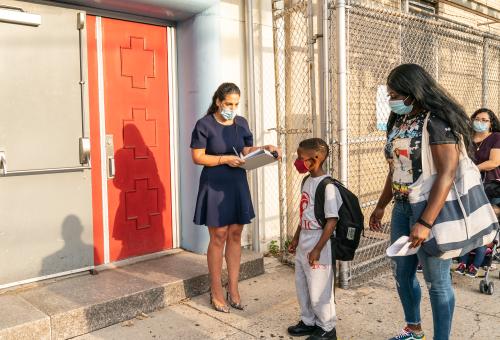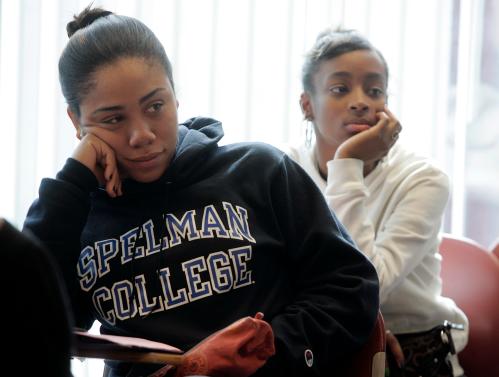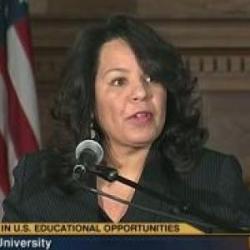Portions of this essay are extracted from Jim Crow’s Pink Slip.
June 15, 1971. That was the day that the groundbreaking 1954 Brown v. Topeka Board of Education decision outlawing racial segregation in public schools was narrowly operationalized as being about the racial integration of students.
Following Brown, segregationists waged a protracted fight (known as “massive resistance”) against the new law of the land. This fight resulted in decimation of the ranks of Black principals and teachers. It was so pervasive and severe that its fallout eventually reached the halls of Congress, prompting a series of U.S. Senate Select Committee hearings in 1971 about the displacement and status of Black school principals in desegregating schools. The first day of the hearings was June 14, 1971, which was devoted to in-depth presentations of data, state reports, amicus briefs, and testimonials about the largest purge of educator talent from U.S. public schools. Specifically, that was the illegal firings, dismissals, and demotions of exceptionally credentialed and experienced Black principals and teachers and their replacement by less qualified whites.
By the second day of the hearings—June 15, 1971—the Senate Committee turned its attention away from helping to rectify the illegal treatment of Black principals and teachers because it was concluded that the Nixon administration’s Department of Justice and Department of Health, Education, and Welfare (HEW) was not motivated to resolve the concern. Decades later, this unresolved history continues to stall the nation’s progress toward racial and educational equity.
Here’s the thing: Brown was not intended to simply mean that Black and white students should be educated side-by-side to achieve integrated schools. Brown, and many legal decisions subsequent to it, demanded that public schools integrate wholly. The Singleton v. Jackson Municipal Separate School District I and II case and other decisions ruled that during the desegregation process, the administrative ranks, faculty, and student bodies were to become integrated. The failure to integrate school personnel was, and remains, a key part of the unfulfilled promise of Brown.
In fact, as early as 1952, Thurgood Marshall feared that if Brown was successful, Black principals and teachers would be illegally forced from their jobs as educators, leaving newly desegregating school systems with all-white educator corps. At the time, Marshall was an NAACP attorney and chief litigant of Brown. Concerned about the fate of Black educators, the NAACP established the Teacher Information and Security Department to raise funds to assist Black educators with litigating cases that would ensue from illegal firings, dismissals, and demotions by white segregationist school board members and superintendents. The focus was 17 border and southern states with racially segregated public schools (AL, AR, DE, GA, KS, KY, LA, MD, NC, OK, MS, MO, SC, TN, TX, VA, and WV).
100,000 Black Educators Purged and Replaced by Less Qualified White Educators
Brown did not mandate that, for the purposes of integration, all-Black segregated schools would close and all-white segregated schools—with their exclusively white teachers and leaders—would remain open and take in Black students. But that’s exactly what was orchestrated by white segregationists intent on maintaining control of public schools.
At the time, voting rights for Black people were legally restricted and, in most jurisdictions, nonexistent. As a result, few Black people were registered to vote in border and southern states due to discriminatory voting laws, violence, and intimidation. With Black people denied their right to vote, white communities maintained control over public offices (elected and appointed, including superintendent and school board positions), state and local legislative bodies and budgets, and levers of policymaking and implementation. As Black schools were closed in the name of desegregation, personnel and other funds that supported them were diverted to vouchers, tuition grants, and financial aid to support a growing system of all-white private schools under a practice labeled a “voluntary desegregation plan of school choice.” In their rush to stop Brown’s mandate, segregationists initiated a massive resistance strategy that ultimately led to the firing, dismissal, or demotion of 100,000 exceptionally credentialed and experienced Black principals and teachers between 1952 and the late 1970s.
In a riveting account shared with the Senate Select Committee, a Georgia educator, Dr. Bettie M. Smith, explained to the Committee chair how the illegal displacement of Black principals constituted a painful and unfair loss of talent to the nation’s schools. Like most of her Black peers, Smith was well-educated, with a bachelor’s degree from historically Black Tennessee Agricultural and Industrial University (now Tennessee State University) and master’s and doctoral degrees from New York University. Yet, despite her exceptional academic credentials and years of professional success as a principal, she was summarily fired and replaced by a less qualified white male.
Dr. Smith’s experience wasn’t unique. As secretary of the Georgia Council of Secondary School Principals (a Black educator association), Smith told the Committee that she had seen the organization’s membership dwindle from 190 in 1969 to 6 in 1970 because so many Black principals had been removed “due to the integration situation” (meaning the closing of all-Black segregated schools and illegal firings and displacement of Black educators).
During this era—and prior to the passage of Title VI of the Civil Rights Act of 1964 and the Higher Education Act of 1965—Black people were taxpaying citizens but barred by state law from attending their state’s colleges and universities (public and private) in the 17 dual-system states. Generations of Black citizens played by the rules—convoluted, imposing, and insulting as they were—and earned undergraduate degrees at their states’ historically Black colleges and universities (HBCUs). Many then trekked to the Northeast or Midwest to earn master’s and doctoral degrees before returning to their home states to serve as principals and teachers. This academic migration not only made Black educators more academically credentialed than their white counterparts who remained home, but it also provided an experience with integrated education that their white peers never had.
In fact, from the early 1900s, significant numbers of Black principals and teachers earned graduate degrees from some of the nation’s most prestigious universities—primarily, New York University, Columbia University, University of Chicago, Harvard University, University of Michigan, University of Pennsylvania, The Ohio State University, and Iowa State University. Between 1930 and 1960, Columbia University alone awarded 144 doctorates to Black graduates of Historically Black Colleges and Universities (HBCUs).
Their academic migration made a difference in terms of the quality of all-Black segregated schools. For example, the 1926 roster of Sumner High School in Kansas City faculty indicated that 41% of the all-Black faculty held master’s degrees, including three from the University of Chicago. By 1935, the percentage had grown to 61% with master’s degrees. Sumner’s students benefited from the cadre of highly credentialed and effective Black educators, with students known for their stellar achievement in regional and national science fair competitions. (Notably, with the integration of the school’s faculty in 1968 to include more white teachers, the percentage of faculty members with a master’s degree fell to 35%.)
The Senate hearing transcripts are replete with state-by-state reports, research studies, amicus briefs, and letters from affected Black educators testifying to the trauma (and irony) of the most massive purge of educators ever experienced in the U.S. public school system. A 1969 Maryland State Department of Education report was one of many that concluded that Black educators were being replaced by less qualified white candidates:
Since Black principals tend to be more qualified than White principals with respect to degree and certification status, it is necessary for those who appoint principals to provide data that would explain why the discrepancy between Black and White principal [appointments] exist[s].
Owen Kiernan, the executive director of the National Association of Secondary School Principals (a majority-white organization), added his voice to the calls to stop the purposeful decimation of Black educators. Kiernan argued that “the very purpose of school desegregation and integration is made a mockery by this treatment of Negro educators” and that “the problem of the elimination, displacement, and demotion of Negro public school principals [during] desegregation has reached such serious proportions that it requires the intervention of the federal government using its full force and power to bring it to an end.”
Despite the calls to arms, the hemorrhaging continued. Prior to Brown, 35% to 50% of principals and teachers were Black in the 17 dual-system states. Today, no state even approaches these percentages. In fact, less than 7% of the nation’s 3.2 million teachers, 11% of the nation’s 90,000 principals, and 3% of the nation’s nearly 14,000 superintendents are Black. The underrepresentation of Black people in the nation’s educator workforce is tied to the massive resistance to Brown.
A Way Forward
In the mid-1980s, the Carnegie Forum on Education and the Economy declared that “our nation can ill afford a future where its children see almost exclusively white authority figures in their classrooms.” In more recent years, a series of research studies have affirmed the value of schoolchildren experiencing diverse administrative and intellectual authority in their schools’ principals and teachers. These studies clearly show that academic and social benefits accrue to Black students—and, in many cases, non-Black students—who have Black principals and teachers. In these settings, Black students are more likely to be tested for and placed in gifted and talented programs; less likely to be misplaced in special education; more likely to be described by teachers as “intellectually capable;” less likely to be suspended or expelled; more likely to graduate from high school; and more likely to attend college.
To be sure, the overarching goal of school desegregation was to give students the full opportunities that only an open and integrated America could provide. However, with this still-reverberating history, we are left to wonder: Had these generations of Black principals and teachers been integrated into schools after Brown, how might the nation, its schools, and students have benefitted? And what can we do now?
If our nation’s leaders and citizens desire to undo the missed opportunity that the generations of purged Black principals and teachers represented for creating truly integrated schools, a new commitment will emerge to dismember policies that have led to the ideological and financial disinvestment from children of color and those from families experiencing poverty. It will be a dogged insistence to move past deficit perspectives to create teaching and learning environments that affirm the intellectual capacities and cultural heritages of all students. The recommendations that follow are just a few intended to help remedy the long-term harm done by the displacement of Black principals and teachers after Brown:
- Use the newly excavated history shared in Jim Crow’s Pink Slip to inform educator workforce diversity discussions, policies, and intervention programs.
- Invest in HBCU teacher preparation programs. HBCUs are less than 4% of the nation’s colleges/universities yet they produce 50% of the nation’s Black teachers. Prioritizing these institutions with federal and state funding can assist with widening the Black teacher pipeline.
- Invest in efforts that help diversify the ranks of the superintendency and principalship. Less than 3% of the nation’s nearly 14,000 superintendents and 11% of 90,000 principals are Black. Underrepresentation in these key leadership roles is tied to the history of the decimation of the Black educator pipeline.
Racial equity and equal educational opportunity are conjoined goals. It is unlikely that either will be achieved without the other. Our way forward must reflect an abiding belief and dedicated adherence to democratic principles—and a much broader view of what desegregation means.







Commentary
Massive resistance to Brown’s integration decision purged Black educators
May 9, 2023